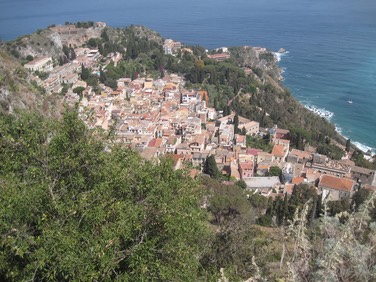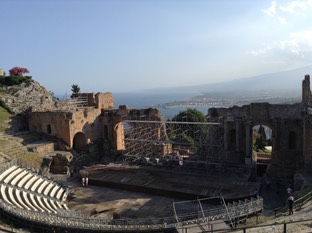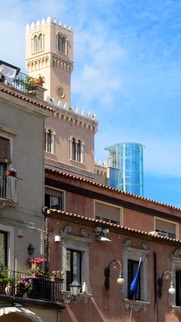
Architects will be immensely gratified to witness longevity in valued buildings but surely it must be even more rewarding to have a design idea adapted, copied and extensively re-used. Almost three thousand years ago an anonymous architect designed one of the finest Greek theatres on a promontory in north east Sicily. No one could have guessed then how many plaudits this remarkable building at Taormina would receive and how influential it would remain throughout the centuries.
The classical arrangement of tiered seating around a circular 'orchestra' was hewn out of the steep hillside around 400BC creating an elegant open air cradle. Taormina's Teatro Greco was built on an axis focused on what is still Europe's most active volcano - Etna. In accordance with Greek tradition the arena was designed both to accommodate and enhance early theatrical performances while simultaneously embracing the spectacular geological drama of this unique site.
The Romans also appreciated the brilliance of this auditorium but were less sentimental about its setting. Gladiatorial combat needed a brick proscenium and arched back stage buildings which for purists vulgarised the composition and obstructed the view. Lebanese MZ Architects recently cited Taormina as inspiration for their Award Winning rock venue -Al Ain Stadium, UAE, which similarly blurs buildings and nature allowing the audience to interact with both the landscape and the performances.

Perhaps this Theatre's most significant legacy is the enduring charm of the ancient town which owes its existence to the arena. Buildings clings to Monte Tauro from sea level to summit and for centuries were inter-connected only by narrow twisting streets and long flights of steps. The bustling commercial centre, Corso Umberto, follows the contours from Porto Messina to Porto Catania at the southern end, and links the town's three public spaces. The central one, Piazza IX Aprile, provides the flattest area in Taormina and is consequently popular for weddings and civic events. This most unusual Piazza however presents its open fourth side as a vertiginous drop to the rugged shoreline far below.
Multicultural influences from Greek, Roman, Norman, Spanish, and Moorish invasions pepper an eclectic architecture. It is however the engineering which really bemuses. Twentieth century transport brought tight looping hairpins, cantilevered concrete and elevated road sections, tunnels and bridges which severely challenge coaches and commercial traffic. Exoskeletal retrofit lift towers protrude through the traditional roof-scape, and in the best 'Movie' tradition hidden lift shafts rise inside caves to clifftop hotels and cable cars shuttle from shops to shore. A theatrical atmosphere embraces all in Taormina.

Goethe is reported to have described the amphitheatre as a "stupendous work of art and nature". Gustav Klimt painted his risque 'ancient theatre in Taormina' here, D H Lawrence, Oscar Wilde, Guy de Maupassant, Kaiser Wilhelm II, and a seemingly endless list of other luminaries have been enthralled by this place.
Films such as "the Godfather" shot in nearby Savoca and the annual Taormina Film Festival now approaching its 60th year ensure that the Greco Teatro remains a busy venue. Russell Crowe and stellar contemporaries collect their International Awards here, and a varied programme of Operas, classical concerts, pop divas and stadium bands continues to elevate the local glamour quotient. The surviving elements of this still busy theatre are predominantly Greek and Roman but with the simple addition of temporary scaffolding and a PA system our anonymous architect seems to have designed the ultimate flexible space and sustainable venue.
568 words